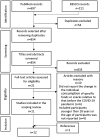Impact of the COVID-19 pandemic on food and drink consumption and related factors: A scoping review
- PMID: 35171054
- PMCID: PMC8855219
- DOI: 10.1177/02601060221078161
Impact of the COVID-19 pandemic on food and drink consumption and related factors: A scoping review
Abstract
Background: The lockdown imposed due to the coronavirus disease (COVID-19) pandemic has caused several lifestyle changes. Aim: This scoping review aimed to report the present status of studies conducted on changes and factors related to food and drink consumption worldwide. Methods: Searches were performed in PubMed and EBSCO between August 6 and August 22, 2020 using the following criteria: (1) studies reporting changes in the current individual consumption of specific foods and snacks compared to that before the COVID-19 pandemic; (2) participants aged 18 years or older and without any diagnosable disease; and (3) articles that are peer-reviewed publications available in English. Studies were excluded if they involved an intervention related to diet or investigated the change in COVID-19 incidence. Results: Twelve articles were included in this review. The included studies revealed that there were various changes in food and drink consumption, such as the frequency and amount of consumption of snacks (n = 9), alcohol (n = 7), and vegetables and fruits (n = 5). These changes showed both increasing and decreasing trends. Of the 12 studies, 10 reported factors related to dietary changes, such as age, body mass index, psychological conditions, and residence; however, most of the results regarding these factors were inconsistent. Conclusions: Future studies should investigate long-term dietary changes and examine the factors that influence these changes to determine the pandemic's long-term impact.
Keywords: COVID-19; factors; food consumption; lockdown; scoping review.
Conflict of interest statement
Figures
Similar articles
-
The impact of COVID-19 lockdown on snacking habits, fast-food and alcohol consumption: A systematic review of the evidence.Clin Nutr. 2022 Dec;41(12):3038-3045. doi: 10.1016/j.clnu.2021.04.020. Epub 2021 Apr 17. Clin Nutr. 2022. PMID: 34049747 Free PMC article.
-
Are Foods from the COVID-19 Pandemic Lockdown Low in Nutrients? An Analysis of Chinese Psychological Distress Effects.Nutrients. 2022 Nov 7;14(21):4702. doi: 10.3390/nu14214702. Nutrients. 2022. PMID: 36364964 Free PMC article.
-
The Impact of Lockdown During the COVID-19 Outbreak on Dietary Habits in Various Population Groups: A Scoping Review.Front Nutr. 2021 Mar 4;8:626432. doi: 10.3389/fnut.2021.626432. eCollection 2021. Front Nutr. 2021. PMID: 33748175 Free PMC article.
-
Changes in diet and physical activity in students during lockdown by example of COVID-19 pandemic.Rocz Panstw Zakl Hig. 2024;75(1):83-91. doi: 10.32394/rpzh.2024.0289. Rocz Panstw Zakl Hig. 2024. PMID: 38587136
-
Dietary Habits and Lifestyle Behaviors of Saudi Residents during the COVID-19 Pandemic: A Cross-Sectional Study.Int J Environ Res Public Health. 2022 Jun 23;19(13):7659. doi: 10.3390/ijerph19137659. Int J Environ Res Public Health. 2022. PMID: 35805318 Free PMC article.
Cited by
-
Consumers' Concerns Regarding Dining Out and Food Hygiene During the COVID-19 Pandemic in Japan: A Web-Based Questionnaire Survey.Cureus. 2025 May 27;17(5):e84923. doi: 10.7759/cureus.84923. eCollection 2025 May. Cureus. 2025. PMID: 40585614 Free PMC article.
-
How Healthy Lifestyle Habits Have Interacted with SARS-CoV-2 Infection and the Effectiveness of COVID-19 Vaccinations: Tohoku Medical Megabank Project Birth and Three-Generation Cohort Study.JMA J. 2024 Jul 16;7(3):353-363. doi: 10.31662/jmaj.2024-0043. Epub 2024 Jul 3. JMA J. 2024. PMID: 39114619 Free PMC article.
-
Determinants of Changes in the Diet Quality of Japanese Adults during the Coronavirus Disease 2019 Pandemic.Nutrients. 2022 Dec 27;15(1):131. doi: 10.3390/nu15010131. Nutrients. 2022. PMID: 36615788 Free PMC article.
-
Dietary Differences by Job Type and Industry Among Workers in Japan During the COVID-19 Pandemic: A Cross-Sectional Study.Am J Lifestyle Med. 2024 Sep 17:15598276241279221. doi: 10.1177/15598276241279221. Online ahead of print. Am J Lifestyle Med. 2024. PMID: 39540168 Free PMC article.
-
Impact of COVID-19 on Dutch General Practitioner Prenatal Primary Care: Retrospective, Observational Cohort Study Using an Interrupted Time-Series Approach.JMIR Pediatr Parent. 2025 May 27;8:e64831. doi: 10.2196/64831. JMIR Pediatr Parent. 2025. PMID: 40424580 Free PMC article.
References
Publication types
MeSH terms
LinkOut - more resources
Full Text Sources
Medical


